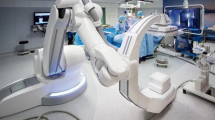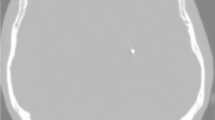Abstract
Deep brain stimulation has become an established therapeutic choice to manage the symptoms of medically refractory Parkinson’s disease. Its efficacy is highly dependent on the accuracy of electrodes’ positioning in the correct anatomical target. During DBS procedure, the opening of the dura mater induces the displacement of neural structures. This effect mainly depends on the loss of the physiological negative intracranial pressure, air inflow, and loss of cerebrospinal fluid. Several studies concentrated on correcting surgical techniques for DBS electrodes’ positioning in order to reduce pneumocephalus which may result in therapeutic failure. The authors focused in particular on reducing the brain air window and maintaining the pressure gradient between intra- and extracranial compartments. A significant reduction of pneumocephalus and brain shift was obtained by excluding the opening of the subarachnoid space, by covering the dura mater opening with tissue sealant and by reducing the intracranial pressure in general anesthesia. Smaller burr hole diameters were not statistically relevant for reducing air inflow and displacement of anatomical targets. The review of the literature showed that conserving a physiological intra-extracranial pressure gradient plays a fundamental role in avoiding pneumocephalus and consequent displacement of brain structures, which improves surgical accuracy and DBS long-term results.

Similar content being viewed by others
References
Azmi H, Machado A, Deogaonkar M, Rezai A (2011) Intracranial air correlates with preoperative cerebral atrophy and stereotactic error during bilateral STN DBS surgery for Parkinson’s disease. Stereotact Funct Neurosurg 89(4):246–252. https://doi.org/10.1159/000327916
Bentley JN, Guan Z, Cummings KS, Chou KL, Patil PG (2017) Influence of intracranial air on electrode position and clinical outcomes following deep brain stimulation for Parkinson's disease. Stereotact Funct Neurosurg 95(1):6–12. https://doi.org/10.1159/000452843
Choi KS, Noecker AM, Riva-Posse P, Rajendra JK, Gross RE, Mayberg HS, McIntyre CC (2018) Impact of brain shift on subcallosal cingulate deep brain stimulation. Brain Stimul 11(2):445–453. https://doi.org/10.1016/j.brs.2017.12.001
Coenen VA, Abdel-Rahman A, McMaster J, Bogod N, Honey CR (2011) Minimizing brain shift during functional neurosurgical procedures - a simple burr hole technique that can decrease CSF loss and intracranial air. Cent Eur Neurosurg 72:181–185. https://doi.org/10.1055/s-0031-1279748
Fonoff ET, Azevedo A, Angelos JS, Martinez RC, Navarro J, Reis PR, Sepulveda ME, Cury RG, Ghilardi MG, Teixeira MJ, Lopez WO (2016) Simultaneous bilateral stereotactic procedure for deep brain stimulation implants: a significant step for reducing operation time. J Neurosurg 125(1):85–89. https://doi.org/10.3171/2015.7.JNS151026
Hakim S, Venegas JG, Burton JD (1976) The physics of the cranial cavity, hydrocephalus and normal pressure hydrocephalus: mechanical interpretation and mathematical model. Surg Neurol 5:187–210
Ko AL, Magown P, Ozpinar A, Hamzaoglu V, Burchiel KJ (2018) Asleep deep brain stimulation reduces incidence of intracranial air during electrode implantation. Stereotact Funct Neurosurg 96(2):83–90. https://doi.org/10.1159/000488150
Krack P, Batir A, Van Blercom N, Chabardes S, Fraix V, Ardouin C, Koudsie A, Limousin PD, Benazzouz A, LeBas JF, Benabid AL, Pollak P (2003) Five-year follow-up of bilateral stimulation of the subthalamic nucleus in advanced Parkinson's disease. N Engl J Med 349(20):1925–1934. https://doi.org/10.1056/NEJMoa035275
Li Z, Zhang JG, Ye Y, Li X (2016) Review on factors affecting targeting accuracy of deep brain stimulation electrode implantation between 2001 and 2015. Stereotact Funct Neurosurg 94:351–362. https://doi.org/10.1159/000449206
Limousin P, Krack P, Pollak P, Benazzouz A, Ardouin C, Hoffmann D, Benabid AL (1998) Electrical stimulation of the subthalamic nucleus in advanced Parkinson's disease. N Engl J Med 339:1105–1111. https://doi.org/10.1056/NEJM199810153391603
Lujan JL, Chaturvedi A, Choi KS, Holtzheimer PE, Gross RE, Mayberg HS, McIntyre CC (2013) Tractography-activation models applied to subcallosal cingulate deep brain stimulation. Brain Stimul 6(5):737–739. https://doi.org/10.1016/j.brs.2013.03.008
Martin AJ, Larson PS, Ostrem JL, Sootsman WK, Talke P, Weber OM, Levesque N, Myers J, Starr P (2005) Placement of deep brain stimulator electrodes using real-time highfield interventional magnetic resonance imaging. Magn Reson Med 54:1107–1114
Miyagi Y, Shima F, Sasaki T (2007) Brain shift: an error factor during implantation of deep brain stimulation electrodes. J Neurosurg 107:989–997
Okun MS, Tagliati M, Pourfar M, Fernandez HH, Rodriguez RL, Alterman RL, Foote KD (2005) Management of referred deep brain stimulation failures: a retrospective analysis from 2 movement disorders centers. Arch Neurol 62:1250–1255
Pang D, Altschuler E (1994) Low-pressure hydrocephalic state and viscoelastic alterations in the brain. Neurosurgery 35:643–656
Riva-Posse P, Choi KS, Holtzheimer PE, Crowell AL, Garlow SJ, Rajendra JK, McIntyre CC, Gross RE (2018) Mayberg HS a connectomic approach for subcallosal cingulate deep brain stimulation surgery: prospective targeting in treatment-resistant depression. Mol Psychiatry 23(4):843–849. https://doi.org/10.1038/mp.2017.59
Rodriguez-Oroz MC, Rodriguez M, Guridi J, Mewes K, Chockkman V, Vitek J, DeLong MR, Obeso JA (2001) The subthalamic nucleus in Parkinson’s disease: somatotopic organization and physiological characteristics. Brain 124(Pt 9):1777–1790. https://doi.org/10.1093/brain/124.9.1777
Romanelli P, Heit G, Hill BC, Kraus A, Hastie T, Bronte-Stewart HM (2004) Microelectrode recording revealing a somatotopic body map in the subthalamic nucleus in humans with Parkinson disease. J Neurosurg 100:611–618. https://doi.org/10.3171/jns.2004.100.4.0611
Rughani A, Schwalb JM, Sidiropoulos C, Pilitsis J, Ramirez-Zamora A, Sweet JA, Mittal S, Espay AJ, Martinez JG, Abosch A, Eskandar E, Gross R, Alterman R (2018) Hamani C (2018) Congress of Neurological Surgeons systematic review and evidence-based guideline on subthalamic nucleus and globus pallidus internus deep brain stimulation for the treatment of patients with Parkinson's disease: executive summary. Neurosurgery. 82(6):753–756. https://doi.org/10.1093/neuros/nyy037
Sasaki T, Agari T, Kuwahara K, Kin I, Okazaki M, Sasada S, Shinko A, Kameda M, Yasuhara T, Date I (2018) Efficacy of dural sealant system for preventing brain shift and improving accuracy in deep brain stimulation surgery. Neurol Med Chir (Tokyo) 58(5):199–205. https://doi.org/10.2176/nmc.oa.2017-0242
Sharim J, Pezeshkian P, DeSalles A, Pouratian N (2015) Effect of cranial window diameter during deep brain stimulation surgery on volume of pneumocephalus. Neuromodulation 18(7):574–578 discussion 578-9
Takumi I, Mishina M, Hironaka K, Oyama K, Yamada A, Adachi K, Hamamoto M, Kitamura S, Yoshida D, Teramoto A (2013) Simple solution for preventing cerebrospinal fluid loss and brain shift during multitrack deep brain stimulation surgery in the semisupine position: polyethylene glycol hydrogel dural sealant capping: rapid communication. Neurol Med Chir (Tokyo) 53:1–6
Umemura A, Oka Y, Yamada K, Oyama G, Shimo Y, Hattori N (2013) Validity of single tract microelectrode recording in subthalamic nucleus stimulation. Neurol Med Chir (Tokyo) 53(11):821–827. https://doi.org/10.2176/nmc.oa2012-0412
Van Den Munckhof P, Contarino MF, Bour LJ, Speelman JD, De Bie RMA, Schuurman PR (2010) Postoperative curving and upward displacement of deep brain stimulation electrodes caused by brain shift. Neurosurgery 67:49–53
Vassilyadi M, Farmer JP, Montes JL (1995) Negative-pressure hydrocephalus. J Neurosurg 83:486–490
Author information
Authors and Affiliations
Corresponding author
Ethics declarations
Conflict of interest
The authors declare that they have no conflict of interest.
Ethical approval
Ethical approval was not required because this study is a systematic review and does not involve original data.
Informed consent
Informed consent was not required because this study is a systematic review and does not involve original data.
Additional information
Publisher’s note
Springer Nature remains neutral with regard to jurisdictional claims in published maps and institutional affiliations.
Rights and permissions
About this article
Cite this article
Beggio, G., Raneri, F., Rustemi, O. et al. Techniques for pneumocephalus and brain shift reduction in DBS surgery: a review of the literature. Neurosurg Rev 43, 95–99 (2020). https://doi.org/10.1007/s10143-019-01220-2
Received:
Revised:
Accepted:
Published:
Issue Date:
DOI: https://doi.org/10.1007/s10143-019-01220-2




